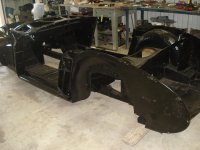I second the non use of chemicals.......in visualizing the penetration of the chemicals, and then the neutralizing agents, It seems to me the neutralizing agents won't really penetrate as far as the acid, leaving areas where acid is still active....but just my ranting...not proven in fact. Unfortunately, it takes a very long time to prove the acid will never fail the paint system, but I've heard of instances of that happening....not saying that improvements haven't been made to the compenents or the processes.
I personnally had my frame blasted, not sand blasted but mineral blasted by a firm in Sacramento. They use a material similar to soda, but darker and apparently better in removing the rust. The particles are very fine, able to penetrate the fine pits made by rust but not heavy enough to warp the sheetmetal frame/substructure. Then I had them apply the epoxy primer to the frame, and they did uncover areas that were not apparent initially that had major rust damage. I repaired the rust damage afterwards and applied epoxy primer to repaired areas after the blasting/primer. I painted afterwards, some years later, after roughing up the primer with scuff pads. I also left the removed blasted and primered sections of a fender out in the weather for a few years to see if the process was effective, and I'm happy to report no rust surfaced. So far so good after about 10 years, but then I don't drive in the rain if I can avoid it....but then we live in Oregon...so its a difficult proposition.
As for stopping the rust inside the frame, I just used a 3M product, similar to waxoyl. All you need to do is stop the moisture from penetrating, and from the thickness testing I did on the frame, internal rust wasn't really an issue. If you do have major internal rust, then frame replacement should be considered. There are also rust conversion products the would work also, if it isn't serious.

 Hi Guest!
Hi Guest!

 smilie in place of the real @
smilie in place of the real @
 Pretty Please - add it to our Events forum(s) and add to the calendar! >>
Pretty Please - add it to our Events forum(s) and add to the calendar! >> 




